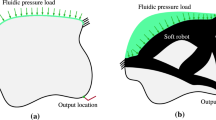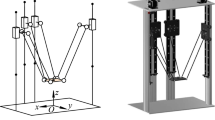Abstract
This paper investigates a new approach for the control of Mobile Cable-Driven Parallel Robots (MCDPR) called the Hybrid tension–length compensation algorithm (HTLCA). The Cable-Driven Parallel Robot (CDPR) system controls the end-effector using cables, which is a different system structure from robots with rigid arms or Cartesian methods. The MCDPR combines with a mobile robot to overcome the limitations of the CDPR system, such as limited spatial mobility and the ability to achieve a larger workspace, providing higher degrees of freedom and efficient working space. However, there is currently no robust solution to control the end-effector in real-time and stability in dynamic environments. Therefore, this study proposes the HTLCA to compensate for control errors caused by various factors in dynamic environments. The proposed algorithm performs hybrid force and length closed-loop PID control using the calculated tension distribution algorithm (TDA) values of the cables for the end-effector position, target length values, and the measured tension distribution and length values of the current cables. Experimental results using the proposed HTLCA algorithm in CDPR and MCDPR modes show a 57.20% reduction in tension control errors compared to before its application in a mobile robot's driving environment. Therefore, HTLCA effectively compensates for errors by simultaneously controlling the tension distribution and length of the cables, improving dynamic performance, and ensuring stable control, thus demonstrating its validity.













Similar content being viewed by others
Data availability
The data supporting the findings of this study, which include MCDPR robot's driving data, are available upon request. Please contact Kyoung-Su Park at pks6348@gachon.ac.kr for access to the data. Restrictions may apply to the availability of these data, which were used under license for this study.
References
Babaghasabha R, Khosravi MA, Taghirad HD (2015) Adaptive robust control of fully-constrained cable driven parallel robots. Mechatronics 25:27–36
Bostelman RV, Albus JS (1993) Stability of an underwater work platform suspended from an unstable reference. In: Proceedings of OCEANS'93, pp 325
Bostelman RV, Dagalakis NG, Albus JS (1993) A robotic crane system utilizing the Stewart platform configuration. In: Proceedings of the ISRAM'92 conference, Santa Fe, NM
Bostelman RV, Albus JS, Murphy K, Tsai TM, Amatucci E (1994) A stewart platform lunar rover. In: Engineering construction and operations in space IV proceeding, Albuquerque, NM, Feb
Brown G (1985) Skycam: an aerial robotic camera system. In: BYTE, 122
Carpio-Alemán MA, Saltaren-Pasmino RJ, Rodríguez A, Portilla GA, Cely JS, Gonzalez-Alvarez NX, Castillo-Guerrero JM (2018) Collision and tension analysis of cable-driven parallel robot for positioning and orientation. In: 2018 IEEE international autumn meeting on power, electronics and computing (ROPEC), pp 1–6
Côté AF, Cardou P, Gosselin C (2016) A tension distribution algorithm for cable-driven parallel robots operating beyond their wrench-feasible workspace. In: 2016 16th international conference on control, automation and systems (ICCAS), pp 68–73
Fabritius M, Rubio-Gómez G, Martin C, Santos JC, Kraus W, Pott A (2023) A nullspace-based force correction method to improve the dynamic performance of cable-driven parallel robots. Mech Mach Theory 181:105177
Fabritius M, Martin C, Gomez GR, Kraus W, Pott A (2021) A practical force correction method for over-constrained cable-driven parallel robots. In: International conference on cable-driven parallel robots, pp 117–128
Gagliardini L, Gouttefarde M, Caro S (2018) Design of reconfigurable cable-driven parallel robots. In: Mechatronics for cultural heritage and civil engineering, pp 85–113
Gosselin C (2014) Cabledriven parallel mechanisms: state of the art and perspectives. Mech Eng Rev 1(1):4
Gouttefarde M, Lamaury J, Reichert C, Bruckmann T (2015) A versatile tension distribution algorithm for n-DOF parallel robots driven by n+2 cables. IEEE Trans Rob 31(6):1444–1457
Jeong JW, Kim SH, Kwak YK (1998) Design and kinematic analysis of the wire parallel mechanism for a robot pose measurement. In: Proceedings. 1998 IEEE international conference on robotics and automation (Cat. No. 98CH36146) 4:2941–2946)
Ji H, Shang W, Cong S (2020) Adaptive synchronization control of cable-driven parallel robots with uncertain kinematics and dynamics. IEEE Trans Ind Electron 68(9):8444–8454
Kawamura S, Kino H, Won C (2000) High-speed manipulation by using parallel wire-driven robots. Robotica 18(1):13–21
Korayem MH, Yousefzadeh M, Manteghi S (2017) Dynamics and input–output feedback linearization control of a wheeled mobile cable-driven parallel robot. Multibody SysDyn 40:55–73
Kraus W (2016) Force control of cable-driven parallel robots. p 24
Lafourcade P, Llibre M, Reboulet C (2002) Design of a parallel wire-driven manipulator for wind tunnels. In: Proceedings of the workshop on fundamental issues and future research directions for parallel mechanisms and manipulators, pp 187–194. Quebec City, Canada
Le Nguyen V, Caverly RJ (2021) Cable-driven parallel robot pose estimation using extended Kalman filtering with inertial payload measurements. IEEE Robot Autom Lett 6(2):3615–3622
Mao Y, Jin X, Dutta GG, Scholz JP, Agrawal SK (2014) Human movement training with a cable driven arm exoskeleton (CAREX). IEEE Trans Neural Syst Rehabil Eng 23(1):84–92
Mattioni V, Idà E, Carricato M (2022) Force-distribution sensitivity to cable-tension errors in overconstrained cable-driven parallel robots. Mech Mach Theory 175:104940
Morizono T, Kurahashi K, Kawamura S (1998) Analysis and control of a force display system driven by parallel wire mechanism. Robotica 16(5):551–563
Oh SR, Ryu JC, Agrawal SK (2006) Dynamics and control of a helicopter carrying a payload using a cable-suspended robot. J Mech Des Sep 128:1113
Pedemonte N, Rasheed T, Marquez-Gamez D, Long P, Hocquard É, Babin F, Caro S (2020) Fastkit: a mobile cable-driven parallel robot for logistics. Advances in robotics research: from lab to market: ECHORD++: robotic science supporting innovation. Springer, Cham, pp 141–163
Rasheed T, Long P, Marquez-Gamez D, Caro S (2018) Tension distribution algorithm for planar mobile cable-driven parallel robots. In: Cable-driven parallel robots: proceedings of the third international conference on cable-driven parallel robots, pp 268–279
Rasheed T, Long P, Roos AS, Caro S (2019) Optimization based trajectory planning of mobile cable-driven parallel robots. In: 2019 IEEE/RSJ International Conference on Intelligent Robots and Systems (IROS), pp 6788–6793. IEEE
Rosati G, Gallina P, Masiero S Rossi A (2005) Design of a new 5 d.o.f. wire-based robot for rehabilitation. In: 9th International conference on rehabilitation robotics, 2005. ICORR 2005., pp. 430–433
Tan H, Nurahmi L, Pramujati B, Caro S (2020) On the reconfiguration of cable-driven parallel robots with multiple mobile cranes. In: 2020 5th International conference on robotics and automation engineering (ICRAE), pp 126–130
Tho TP, Thinh NT (2022) An overview of cable-driven parallel robots: workspace, tension distribution, and cable sagging. Math Probl Eng 2022:2199748
Wang W, Tang X, Shao Z, Yang J, Yi W (2014) Design and analysis of a wire-driven parallel mechanism for low-gravity environment simulation. Adv Mech Eng 6:810606
Xu J, Park KS (2020) A real-time path planning algorithm for cable-driven parallel robots in dynamic environment based on artificial potential guided RRT. Microsyst Technol 26:3533–3546
Xu J, Park KS (2022) Kinematic performance-based path planning for cable-driven parallel robots using modified adaptive RRT. Microsyst Technol 28(10):2325–2336
Xu J, Kim BG, Feng X, Park KS (2023a) Online motion planning of mobile cable-driven parallel robots for autonomous navigation in uncertain environments. Complex Intell Syst 10:397–412
Xu J, Kim BG, Park KS (2023b) A collaborative path planning method for mobile cable-driven parallel robots in a constrained environment with considering kinematic stability. Complex Intell Syst 9(5):4857–4868
Yao R, Li H, Zhang X (2013) A modeling method of the cable driven parallel manipulator for FAST. Cable-driven parallel robots. Springer, Berlin, pp 423–436
Zhang Z, Shao Z, Wang L, Shih AJ (2018) Optimal design of a high-speed pick-and-place cable-driven parallel robot. In: Cable-driven parallel robots: proceedings of the third international conference on cable-driven parallel robots, pp 340–352
Acknowledgements
This research was carried out with the support of the RCMS project of the Korea Evaluation Institute of Industrial Technology (RCMS), “Development of InLine System for TTV Improvement and Handling of Semiconductor Ultra-Thin Wafer” (20017476) and supported by the National Research Foundation of Korea(NRF) grant funded by the Korea government(MSIT) (2021R1A2C2013053).
Author information
Authors and Affiliations
Contributions
Dong-Yeop Shin (DYS) developed the control algorithm, conducted experiments, performed data analysis, and wrote the main manuscript text. Byeong-Geon Kim (BGK) assisted in reviewing the control algorithm, provided advice, and contributed to the development, maintenance, and review of the experimental setup. Seok-Kyu Hong (SKH) and Jin-Hwan Lim (JHL) assisted in the development of the experimental setup and provided support during the experiments and data processing. Professor Kyoung-Su Park (KSP) supervised and guided the research as the principal investigator.
Corresponding author
Ethics declarations
Conflict of interest
Author Dong-Yeop Shin declares that he has no conflict of interest. Author Byeong-Geon Kim declares that he has no conflict of interest. Author Jin-huwan Lim declares that he has no conflict of interest. Author Seok-Gyu Hong declares that he has no conflict of interest. Author Kyoung-Su Park declares that he has no conflict of interest.
Additional information
Publisher's Note
Springer Nature remains neutral with regard to jurisdictional claims in published maps and institutional affiliations.
Rights and permissions
Springer Nature or its licensor (e.g. a society or other partner) holds exclusive rights to this article under a publishing agreement with the author(s) or other rightsholder(s); author self-archiving of the accepted manuscript version of this article is solely governed by the terms of such publishing agreement and applicable law.
About this article
Cite this article
Shin, DY., Kim, BG., Lim, JH. et al. Hybrid cable tension–length compensation algorithm for dynamic performance improvement of mobile cable-driven parallel robot. Microsyst Technol (2024). https://doi.org/10.1007/s00542-024-05673-4
Received:
Accepted:
Published:
DOI: https://doi.org/10.1007/s00542-024-05673-4




